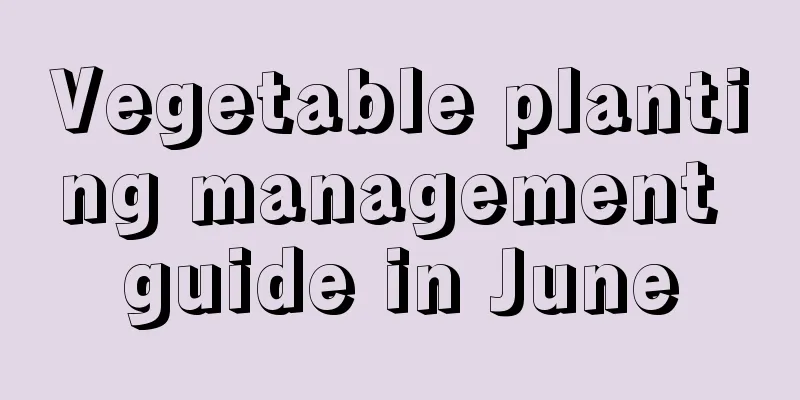Vegetable planting management guide in June

|
In June, with the arrival of summer, the temperature gradually rises and vegetables enter a rapid growth period. In order to ensure the normal growth of vegetables, appropriate management measures must be taken, which is also the key to ensuring high yields in the later period. Here is a guide to vegetable planting and management in June. 1. Sow seeds at the right time In June, you can plant some warm-loving vegetables, such as cucumbers, peppers, eggplants, beans, etc. It is generally recommended to choose a plot with high terrain, good drainage, convenient watering, and loose and fertile soil for planting. 2. Shade and cool down As the temperature gradually rises in June, it is necessary to use shade nets or straw on the seedbed to provide shade, cool down and moisturize the seeds. You should also water frequently to keep the soil in the seedbed moist and create a suitable growing environment for the vegetables. 3. Water and fertilizer management Water the vegetables appropriately according to their growth, keeping the soil moist but avoiding waterlogging. It is best to water in the morning or evening, and avoid watering at noon on a sunny day. When applying fertilizer, pay attention to applying thin fertilizers frequently and combine it with watering. For vegetables that are difficult to grow in summer and prone to premature aging, such as peppers, watermelons, bitter gourds, etc., balanced or high-potassium fertilizers can be applied to improve their resistance to stress. 4. Prevent waterlogging and drought Before the arrival of the plum rain, clean the drainage ditches, dredge the "three ditches" in the fields, remove water from the fields in time, straighten and fix fallen plants, and till the soil or build up the soil to nourish the roots in due course. At the same time, pay attention to drought prevention, use irrigation pools and water cellars to store rainwater, and irrigate water-savingly during droughts. If there is a continuous drought, combine shallow hoeing, straw or shade net covering to conserve moisture and prevent drought. 5. Plant management Pay attention to controlling the density between plants. If they are too dense, appropriate pruning is needed, ventilation and light transmission between plants should be enhanced, or intercropping with other crops should be carried out appropriately. This can prevent the occurrence of various diseases to a certain extent. 6. Pest and disease control In June, with the changes in temperature and humidity, vegetable diseases and pests also enter a peak period. Common pests and diseases include melon fruit fly, aphids, powdery mildew, etc. In order to effectively prevent and control diseases and pests, comprehensive prevention and control measures should be adopted, including biological control, physical control and chemical control. For example, use yellow boards to trap adult insects, use biological pesticides to control pests, and remove diseased and damaged insects in a timely manner. At the same time, we must strengthen field inspections to promptly detect and deal with pests and diseases. In general, June is a critical period for vegetable planting and management. By taking appropriate management measures based on the growth conditions and environmental conditions of vegetables, we can ensure the healthy growth and stable yield of vegetables in June.
|
<<: How to grow and prune bougainvillea seedlings
Recommend
Can the love vine be propagated by leaf cuttings? Methods and steps for propagation by cuttings
Can the vine of love be planted by leaf cuttings?...
Root Types for Pot Plants
Dew root Exposed roots are also called lifted roo...
What is the meaning of purple hyacinth?
1. Flower language The flower language of purple ...
How to plant sunflowers and the planting season
1. Planting Season As long as the temperature can...
How to store dragon fruit and storage precautions
1. Storage method 1. Place in a cool place: Gener...
White Rose Flower Meaning
1. Flower language introduction The flower langua...
How to prune seven-leaf lotus
Summer pruning In summer, the temperature is high...
What to do if the swallowtail palm is infested with insects
one. Introduction If you want to grow a plant wel...
How to make baby's breath seeds germinate quickly and easily? How long does it take to germinate after sowing?
Gypsophila seeds germination method Step 1 : For ...
When do pomegranates bloom?
1. Flowering time Under normal circumstances, pom...
How to deal with indoor flowers after they wilt
Control watering Due to the small indoor space, t...
7 Phalaenopsis cutting methods
Phalaenopsis is famous for its graceful flowers a...
It is better to water the golden diamond every few days
How often should I water the golden diamond? Gold...
How to care for Kalanchoe when it has buds (how to water and fertilize Kalanchoe when it has buds)
How to care for Kalanchoe after it buds How to ma...
High-yield and high-quality cultivation techniques of water spinach
Water spinach likes warm and humid environment an...









